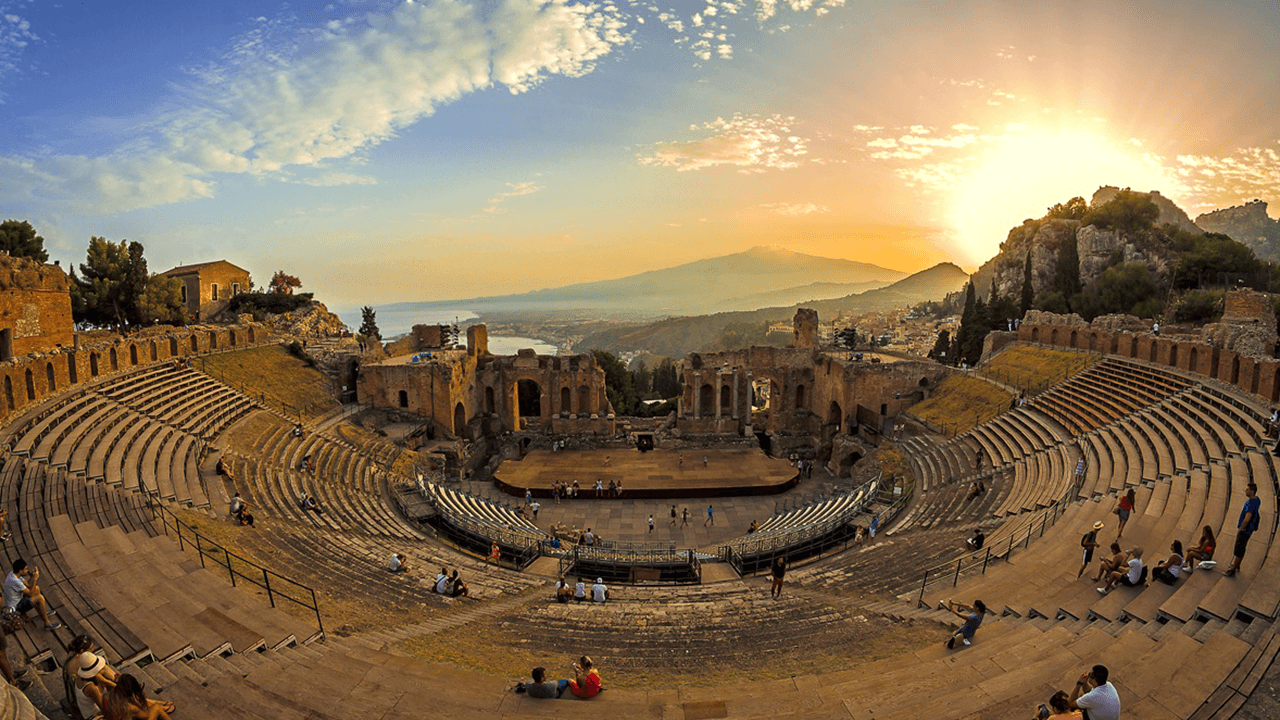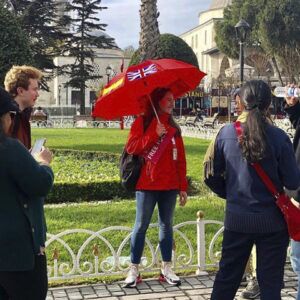The Great Theater of Ephesus: History and Monumental Architecture
The Great Theater of Ephesus is one of the most iconic and best-preserved buildings of the ancient city. This impressive theater, which began as a Hellenistic theater, was expanded and adapted by the Romans in the 1st century AD, reaching a capacity of 25,000 spectators. Located on the slope of Mount Panayir and facing the harbor street, it is easily recognizable for visitors entering from the southern gate of Ephesus.
Structure and Design of the Theater
The structure of the theater stands out for its large horseshoe-shaped cavea, which spans an angle of 220 degrees and has a diameter of 151 meters. The upper row is located 30 meters above the orchestra, providing an impressive view of the entire stage and surrounding landscape.
Access and Vaulted Stairways
The exterior stairs, originally vaulted, facilitated access to the upper rows of the theater, allowing large crowds to enter and exit with ease. This advanced architecture demonstrates the Romans’ ingenuity in constructing efficient and safe public spaces.
The Skene: A Masterpiece of Roman Architecture
The skene, or stage building, is a three-story structure decorated with niches and ornamental motifs that reflect Roman style. Although the original Hellenistic elements are not preserved in this part of the theater, the current ruins display the splendor of Roman architecture.
Layout and Functionality of the Skene
The ground floor of the skene consisted of a long corridor with eight rooms and five large doors leading to the stage. This layout facilitated the movement of actors and provided space for dressing rooms and storage of scenic elements.
The Theater and Saint Paul
This theater is also known for its connection to Saint Paul, who preached to the Ephesians here. According to the story, a silversmith named Demetrius, fearing that Christianity would harm his business of selling Artemis statues to pilgrims, organized a public protest against Paul, shouting, “Great is Diana of the Ephesians!” This event highlights the religious and cultural importance that the theater held in ancient Ephesus.
The Protest of the Artisans
The protest led by Demetrius was motivated by the fear that Paul’s message would affect the local economy, which depended on the sale of images of Artemis, the protective goddess of Ephesus. This episode is an example of how religious and commercial activities were deeply interconnected in the life of the city.
Uses of the Great Theater: Entertainment and Debate
The Great Theater of Ephesus was used not only for theatrical performances and concerts but also for events such as gladiator fights, animal battles, and debates on religious, political, and philosophical topics. This space became a central gathering point for the community, where matters of great relevance to the daily life of the Ephesians were discussed.
Political and Philosophical Activities
In addition to being a center of entertainment, the theater served as a forum for public assemblies and debates. The Ephesians gathered here to discuss matters of community interest, showcasing the multifunctional role of this space in ancient society.
Tips for Visiting the Great Theater of Ephesus
- Location: The theater is located on Panayir Hill, near the southern entrance of the Ephesus ruins, making it easily accessible and visible from various points.
- Best Time to Visit: It is recommended to visit in the early morning or late afternoon to avoid intense heat and to enjoy better lighting for photographs.
- Respect for the Site: As an archaeological site, it is important to respect marked areas and avoid touching or damaging the historical structures.
Conclusion
The Great Theater of Ephesus is an architectural and cultural gem that represents the grandeur of ancient Ephesus. From its impressive design to its significance in the city’s history, this theater offers a window into the past, allowing visitors to understand the public and private life of the ancient Ephesians. Whether for performances or debates, the theater remains a symbol of the cultural richness of this fascinating ancient city.



3 thoughts on “The Grand Theater of Ephesus”
★★★★★
The charm of ‘The Grand Theater of Ephesus’ captivated me entirely. It’s a destination that leaves no one indifferent.
★★★★★
Every moment spent at ‘The Grand Theater of Ephesus’ was filled with wonder and learning. It’s a place I will always cherish.
★★★★★
Looking for an authentic and enriching experience? ‘The Grand Theater of Ephesus’ is the place to be! Absolutely worth the visit.